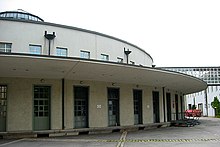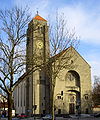Robert Vorhoelzer
Robert Vorhoelzer (born June 13, 1884 in Memmingen , † October 28, 1954 in Munich ) was a German architect , construction clerk , head of the building department of the Munich Oberpostdirektion and professor at the Technical University of Munich .
Robert Vorhoelzer is considered to be the main representative of classical modernism, which is otherwise rather underrepresented in Bavaria . Vorhoelzer developed his main activity as senior building officer of the postal administration in Bavaria. Together with Robert Poeverlein he founded the important " Bavarian Post Building School ".
Life
While in the early phase of his work, for example at the Penzberg post office or at the Ismaninger Strasse post office in Munich, the influence of the "Heimatstyle" can be seen, Vorhoelzer later drew for numerous decidedly modern and functional post offices (post offices, delivery warehouses, residential buildings for postal workers, etc.) in the style of the Responsible for new objectivity . These include, for example, the post office on Tegernseer Landstrasse in Munich- Obergiesing , the post office on Goetheplatz or the post office on Harras in Munich- Sendling (1931/1932) with a white office building in front of it, closed by a rotunda, behind which high apartment blocks rise that give the plaza wall depth. The well thought-out reference that these buildings make to the surrounding urban landscape also shows Vorhoelzer to be a clever urban planner. In particular, the appearance of Munich's Arnulfstrasse is characterized by numerous Vorhoelzer buildings. The former post office in Penzberg was the first building in a project series “Country Post Office”.
In 1930 Vorhoelzer was appointed professor at the Technical University of Munich . During the time of National Socialism , he was deprived of his chair as an alleged "Baubolshevist" in 1933, although he continued to work as an architect, for example the parish church Maria Königin des Friedens in Obergiesing was built during this time (1936/1937) under his leadership . In 1939, on the recommendation of Paul Bonatz, Vorhoelzer went to the Academy of Fine Arts in Istanbul as head of the architecture department , where he succeeded the late Bruno Taut . In Istanbul, where numerous architects such as Clemens Holzmeister , Gustav Oelsner and Walter Schütte lived in forced exile during the Second World War , Vorhoelzer was able to work again as a teacher. Expelled in 1941 on charges of espionage for Nazi Germany, he was too interested in aerial photographs of Turkey, and afterwards took an active part in the war on the German side despite his old age.
After the end of the war he was able to take up his chair in Munich again and in 1946 even became rector of the university. In 1947, however, after allegations concerning the time of his Turkish exile, he was again suspended from duty for six months before he was finally rehabilitated. In the post-war discussion about the reconstruction of Munich, Vorhoelzer pointed out that parts of the city had already been in need of renovation before the war and pleaded for a radically new development plan that relied in particular on low-rise buildings and high-rise buildings. He was also ahead of his time in demanding that the discussion about reconstruction be held “in public”. In 1952, Vorhoelzer retired, and two years later he died at the age of 70 as a result of an operation.
His last major work was the monumental parish church of St. Josef in Dingolfing , which was carried out between 1954 and 1956 after his death. For this hall church , Vorhoelzer continued to develop motifs that he had already used in the Giesingen church “Maria Königin des Friedens”.
Honors
In Munich, the Vorhoelzerstraße in Munich- Solln is named after him.
The “Vorhoelzer Forum” of the Faculty of Architecture at the Technical University of Munich is an event location and roof terrace cafe; Among other things, it serves to promote dialogue between the university and the city.
Works (selection)
- 1922–1924: Upper Post Office building on Arnulfstrasse , Munich
- 1922–1923: Penzberg post office
- 1923: Post office Murnau am Staffelsee (together with Franz Holzhammer and Sigmund Schreiber)
- 1925: Dillingen post office
- 1925: Post Office Deisenhofen (together with Fritz Norkauer )
- 1925: Feldkirchen Post Office
- 1925: Shaftlach post office
- 1925–1926: Parcel delivery office on Arnulfstrasse , Munich
- 1926–1927: Post Office Ismaninger Strasse , Munich
- 1926–1927: Post Office Agnesstraße , Munich (together with Franz Holzhammer and Walther Schmidt )
- 1928–1929: Experimental settlement of the Bavarian Post and Telegraph Association on Arnulfstrasse, Munich (together with Walther Schmidt and Hanna Löv )
- 1928–1929: Post office on Tegernseer Landstrasse , Munich (together with Walther Schmidt)
- 1929: Friedrich Bürklein converts the Frauengebäranstalt on Sonnenstrasse, Munich, into a postal check office
- 1929–1930: Country post office in Grünwald
- 1929–1930: Landschulheim in Schondorf
- 1929–1931: Post office and residential building on Fraunhoferstraße , Munich (together with Walther Schmidt)
- 1931–1932: Post office and residential building on Goetheplatz , Munich (together with Walther Schmidt and Franz Holzhammer)
- 1931–1932: Post office and residential building at Harras, Munich (together with Robert Schnetzer)
- 1933–1934: Bad Tölz post office (together with Karl Schreiber and Hanna Löv)
- 1936–1937: Catholic parish church Maria, Queen of Peace , Munich (together with Walter Scheteling)
- 1946–1947: Reconstruction of the parish church "Maria Königin des Friedens"
- 1949–1954: Reconstruction of the main building of the Technical University of Munich , administration building and library.
- 1954–1957: Construction of the parish church St. Josef in Dingolfing (construction carried out posthumously by Sepp Reiter)
Images (not completely) sorted by location:
Bad Tölz , Ludwigstrasse 10: post office
Dingolfing , Böcklerstraße 2A: St. Josef
Munich , Arnulfstraße 60: former building of the Oberpostdirektion
Munich, Goetheplatz 1: Post office and residential building on Goetheplatz
Munich, Tegernseer Platz 7: Post office on Tegernseer Landstrasse , built between 1928 and 1929
Munich, Werinherstrasse 50: Maria Queen of Peace
Individual evidence
- ↑ Description of use - Vorhoelzer Forum. Retrieved January 25, 2020 .
- ↑ Homepage of the parish of St. Josef in Dingolfing (last viewed: October 5, 2014)
literature
- Luigi Monzo: Building churches in the Third Reich. The inversion of the church's renewal dynamics using the example of the St. Canisius Church in Augsburg designed by Fritz Kempf. In: Das Münster, magazine for Christian art and art history , 68th year 2015/2016, issue 1 (April 2015), pp. 74–82.
- Florian Aicher (Ed.): Robert Vorhoelzer. An architect's life. The classic modernity of the Post. (Accompanying volume to an exhibition in the Munich City Museum and the German Post Museum in Frankfurt am Main) Callwey, Munich 1990, ISBN 3-7667-0960-7 .
- Katharina Blohm, Winfried Nerdinger : Architecture School Munich 1868–1993. Munich 1993.
Web links
- Literature by and about Robert Vorhoelzer in the catalog of the German National Library
- Robert Vorhoelzer. In: arch INFORM .
- Short biography of Jan Lubitz from Vorhoelzer
- The Technical University of Munich on the importance of Vorhoelzer
| personal data | |
|---|---|
| SURNAME | Vorhoelzer, Robert |
| BRIEF DESCRIPTION | German architect and university professor |
| DATE OF BIRTH | June 13, 1884 |
| PLACE OF BIRTH | Memmingen |
| DATE OF DEATH | October 28, 1954 |
| Place of death | Munich |










